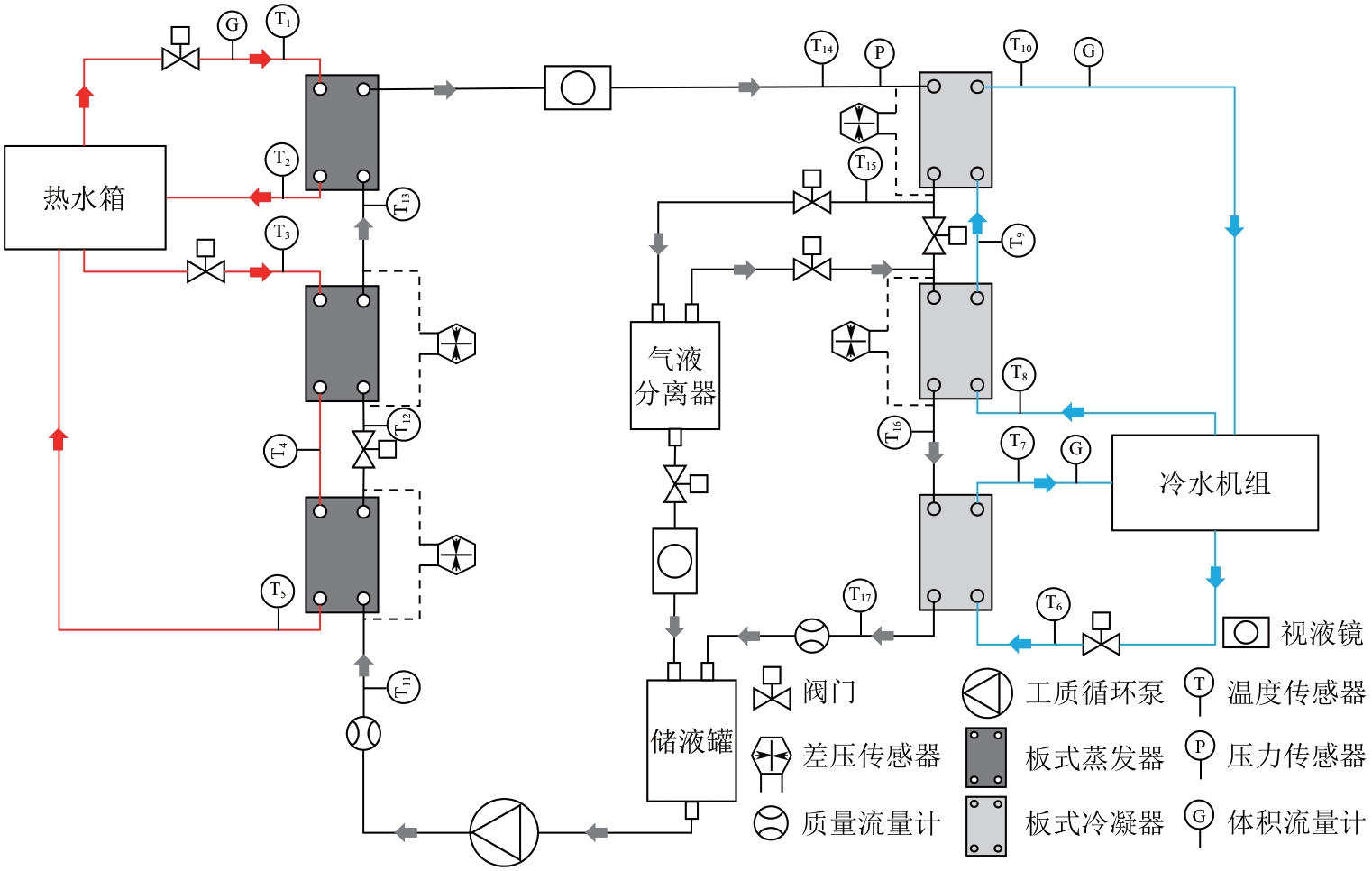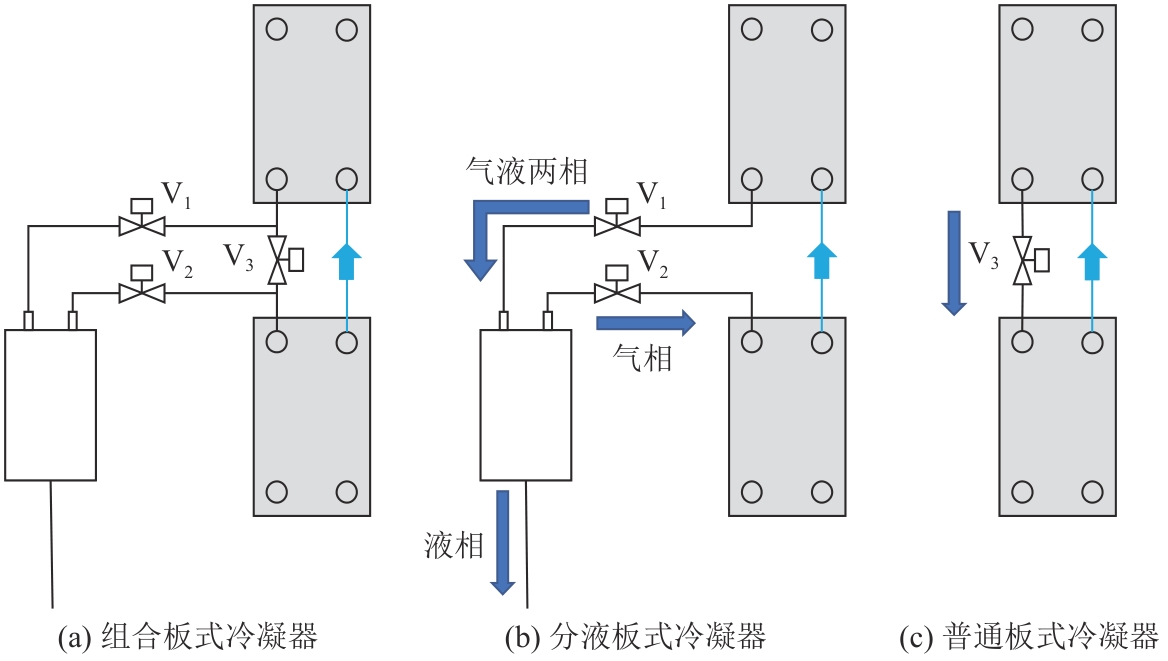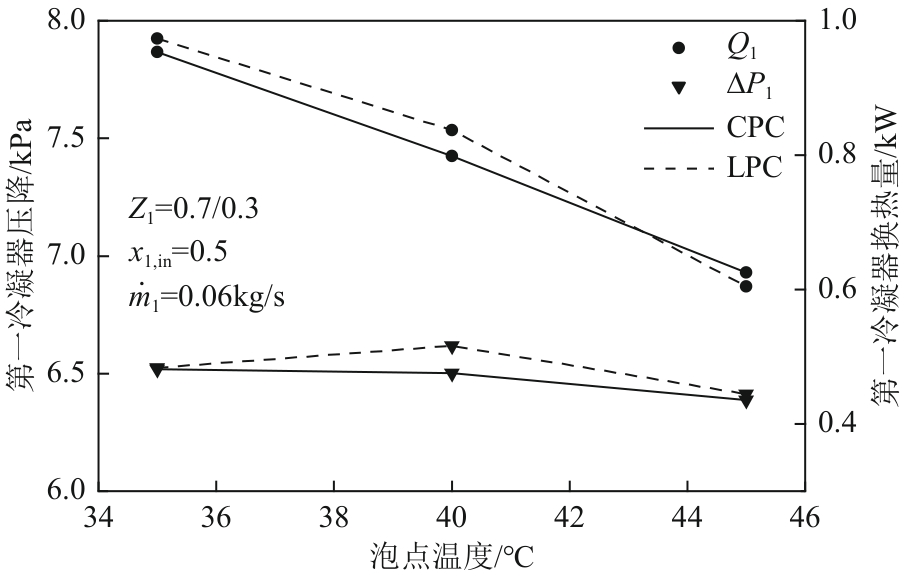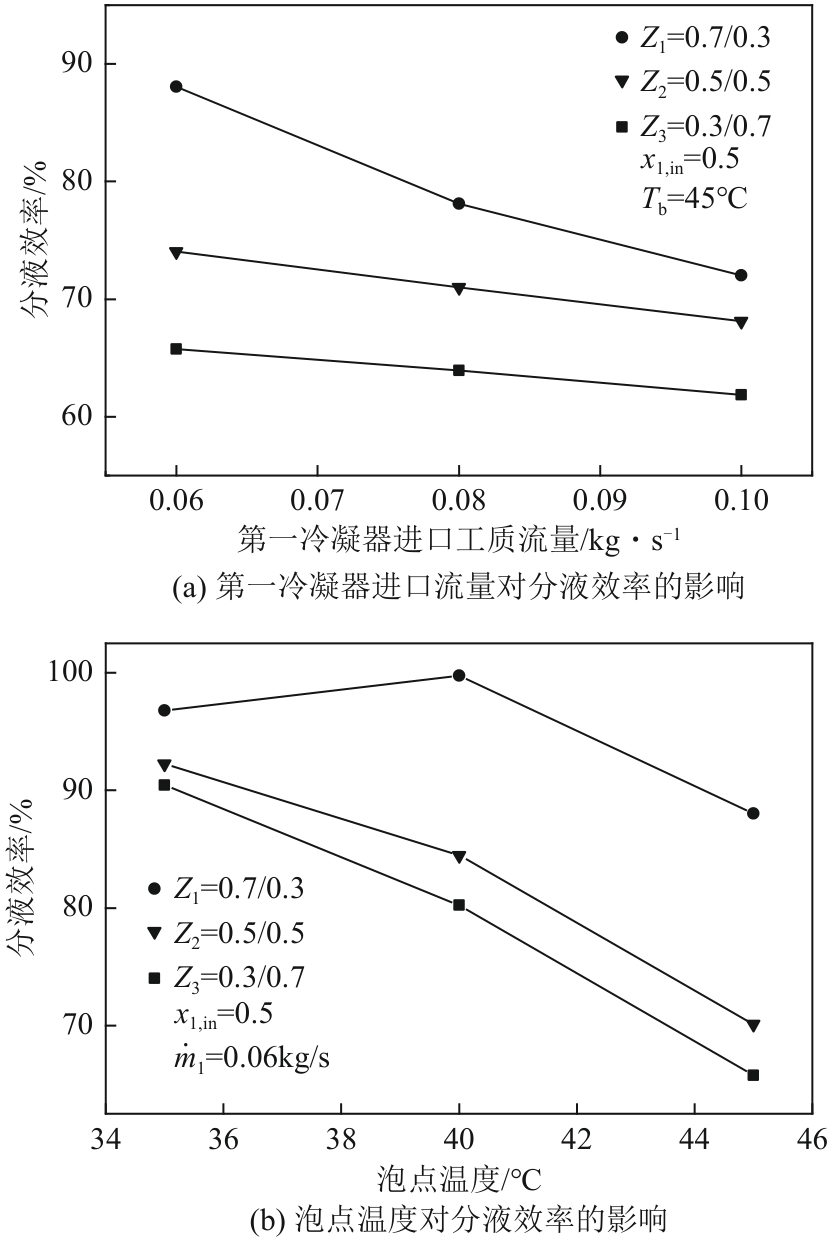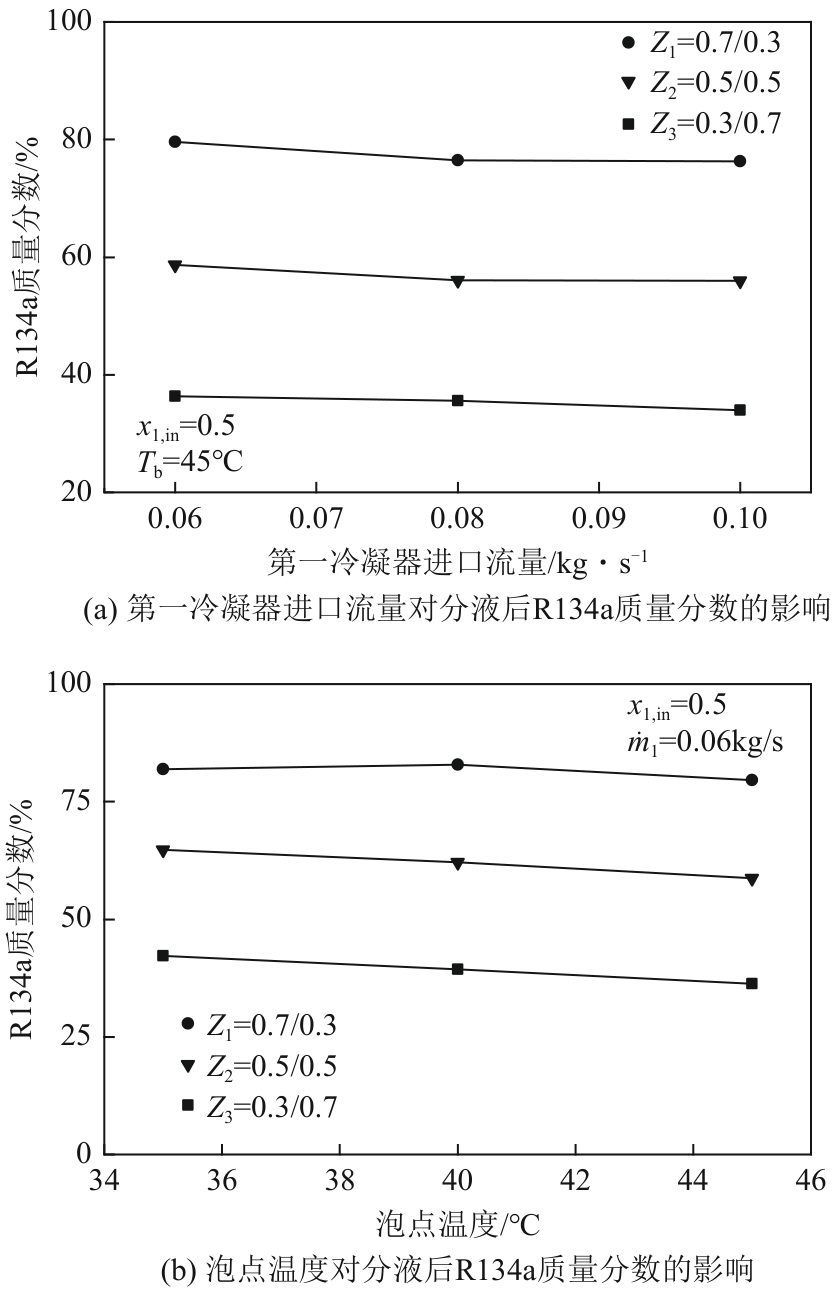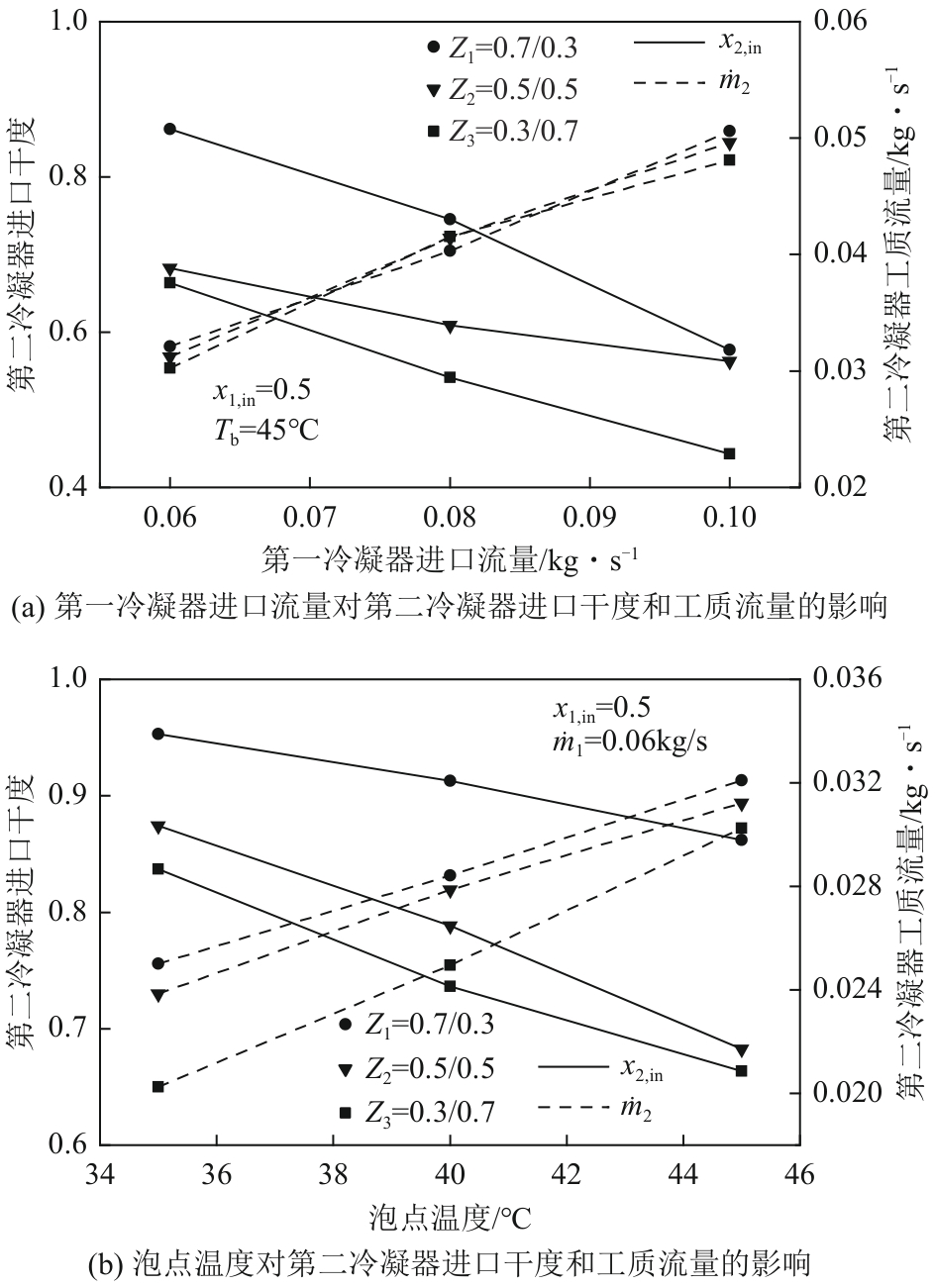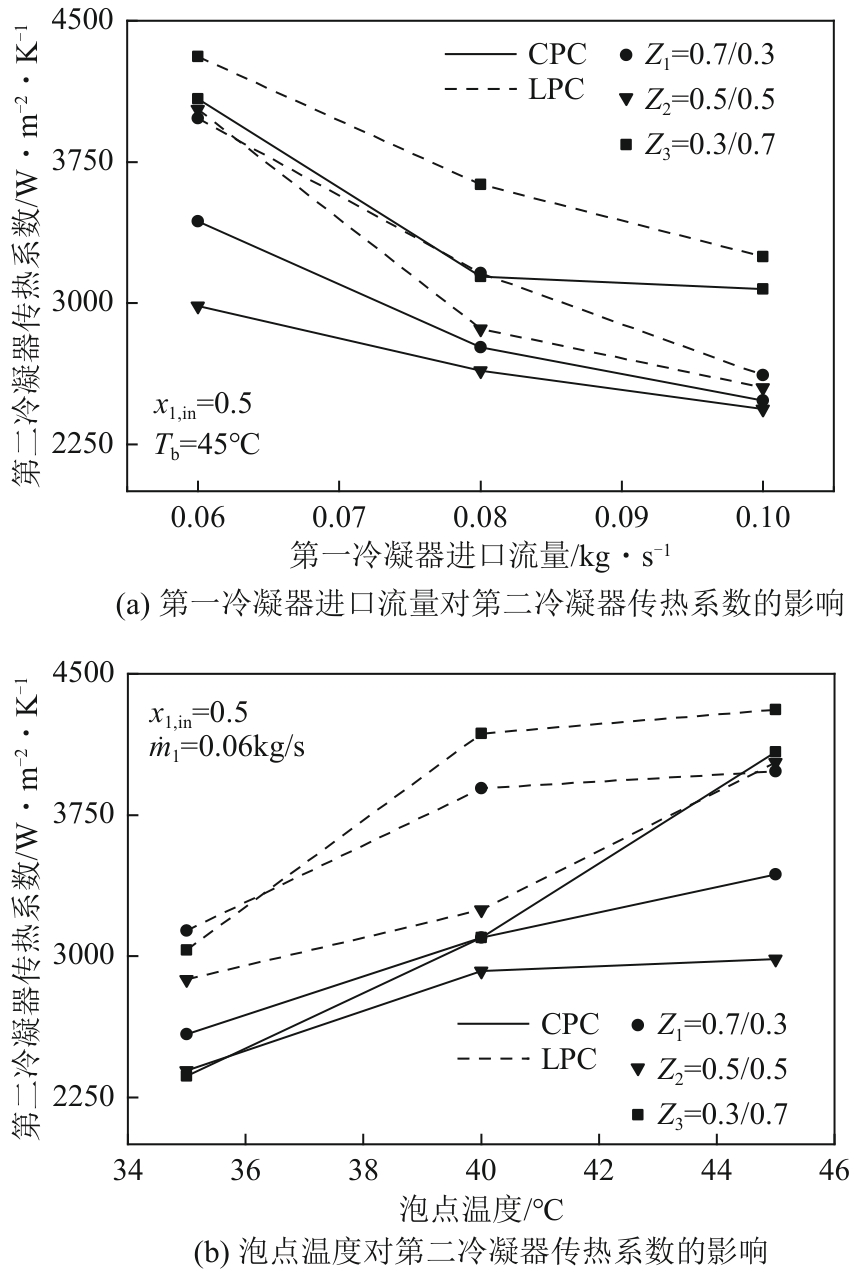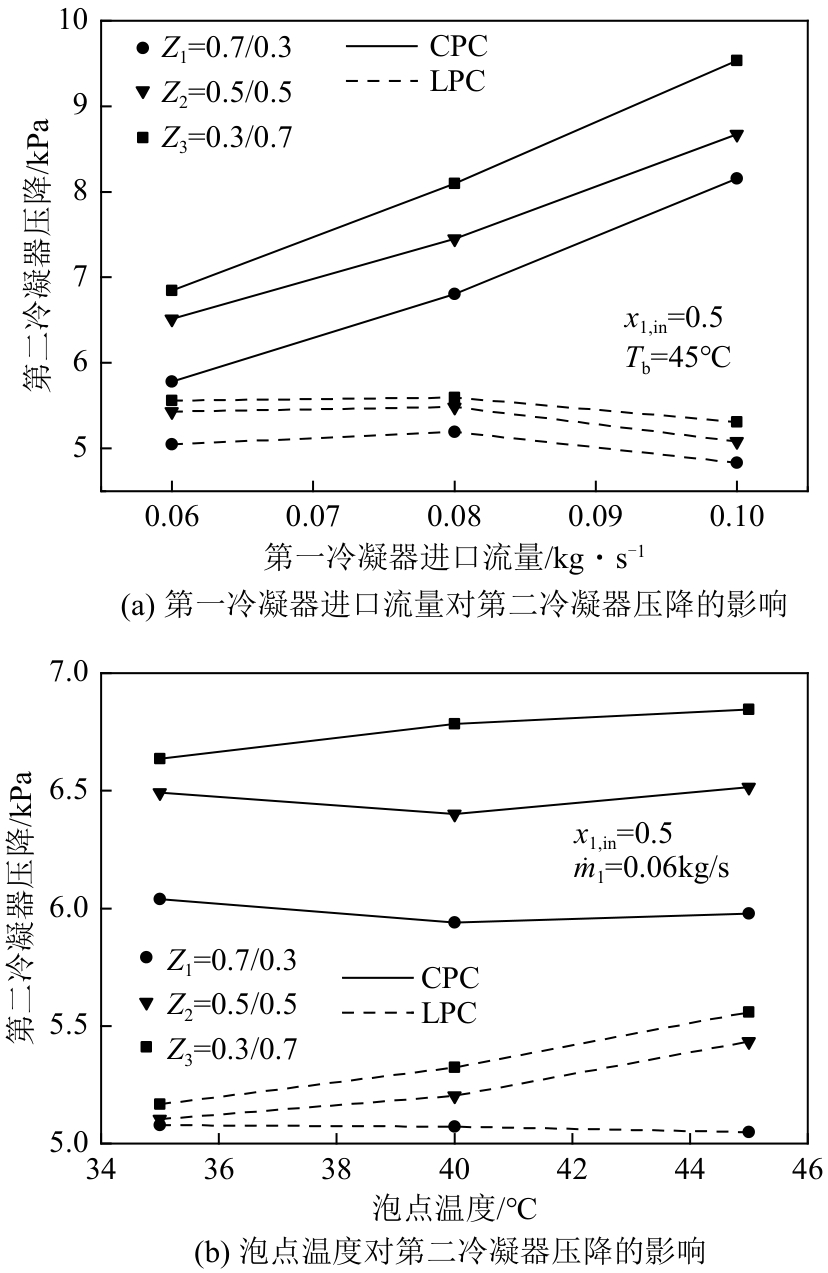Chemical Industry and Engineering Progress ›› 2025, Vol. 44 ›› Issue (1): 48-56.DOI: 10.16085/j.issn.1000-6613.2023-2219
• Chemical processes and equipment • Previous Articles Next Articles
Thermodynamic performance of zeotropic mixtures in liquid-vapor separation plate condenser
CAI Kainan( ), CHEN Jianyong(
), CHEN Jianyong( ), CHEN Ying, LUO Xianglong, LIANG Yingzong, HE Jiacheng
), CHEN Ying, LUO Xianglong, LIANG Yingzong, HE Jiacheng
- School of Materials and Energy, Guangdong University of Technology, Guangzhou 510006, Guangdong, China
-
Received:2023-12-18Revised:2024-05-13Online:2025-02-13Published:2025-01-15 -
Contact:CHEN Jianyong
非共沸工质在分液板式冷凝器中的热力性能
蔡楷楠( ), 陈健勇(
), 陈健勇( ), 陈颖, 罗向龙, 梁颖宗, 何嘉诚
), 陈颖, 罗向龙, 梁颖宗, 何嘉诚
- 广东工业大学材料与能源学院,广东 广州 510006
-
通讯作者:陈健勇 -
作者简介:蔡楷楠(1999—),男,硕士研究生,研究方向为分液冷凝。E-mail:1372522682@qq.com。 -
基金资助:广东省基础与应用基础研究基金自然科学基金(2022A1515012035)
CLC Number:
Cite this article
CAI Kainan, CHEN Jianyong, CHEN Ying, LUO Xianglong, LIANG Yingzong, HE Jiacheng. Thermodynamic performance of zeotropic mixtures in liquid-vapor separation plate condenser[J]. Chemical Industry and Engineering Progress, 2025, 44(1): 48-56.
蔡楷楠, 陈健勇, 陈颖, 罗向龙, 梁颖宗, 何嘉诚. 非共沸工质在分液板式冷凝器中的热力性能[J]. 化工进展, 2025, 44(1): 48-56.
share this article
Add to citation manager EndNote|Ris|BibTeX
URL: https://hgjz.cip.com.cn/EN/10.16085/j.issn.1000-6613.2023-2219
| 主要参数 | 参数值 |
|---|---|
| 换热器宽度/m | 0.116 |
| 换热器高度/m | 0.572 |
| 单板换热面积/m2 | 0.064 |
| 板片数 | 20 |
| 总换热面积/m2 | 0.576 |
| 波纹角/(°) | 60 |
| 主要参数 | 参数值 |
|---|---|
| 换热器宽度/m | 0.116 |
| 换热器高度/m | 0.572 |
| 单板换热面积/m2 | 0.064 |
| 板片数 | 20 |
| 总换热面积/m2 | 0.576 |
| 波纹角/(°) | 60 |
| 仪器名称 | 类型 | 厂家及型号 | 测量范围 |
|---|---|---|---|
| 工质流量计 | 科里奥利流量计 | Emerson-CMF100 | 0.02~0.2kg/s |
| 水侧流量计 | 电磁流量计 | 米科传感-LDG-SUP | 0.3~17m3/h |
| 工质温度传感器 | 赫斯曼PT100温度变送器 | 米科传感-MIK-202 | -50~200℃ |
| 水侧温度传感器 | K型热电偶 | Omega-TT-K-24-SLE | -29~260℃ |
| 工质压力传感器 | 赫斯曼压力变送器 | 米科传感-MIK-P310 | 0~2MPa |
| 工质压差传感器 | 单晶硅压差变送器 | 米科传感-MIK-2051 | 0~2kPa |
| 仪器名称 | 类型 | 厂家及型号 | 测量范围 |
|---|---|---|---|
| 工质流量计 | 科里奥利流量计 | Emerson-CMF100 | 0.02~0.2kg/s |
| 水侧流量计 | 电磁流量计 | 米科传感-LDG-SUP | 0.3~17m3/h |
| 工质温度传感器 | 赫斯曼PT100温度变送器 | 米科传感-MIK-202 | -50~200℃ |
| 水侧温度传感器 | K型热电偶 | Omega-TT-K-24-SLE | -29~260℃ |
| 工质压力传感器 | 赫斯曼压力变送器 | 米科传感-MIK-P310 | 0~2MPa |
| 工质压差传感器 | 单晶硅压差变送器 | 米科传感-MIK-2051 | 0~2kPa |
| 测量参数 | 单位 | 不确定度范围 |
|---|---|---|
| 温度 | ℃ | ±0.2℃ |
| 压力 | kPa | ±0.2% |
| 压降 | kPa | ±0.05% |
| 水流量 | m3/h | ±0.3% |
| 工质流量 | kg/s | ±0.1% |
| 质量分数 | — | ±0.9% |
| 进口干度 | — | ±1.6% |
| 分液效率 | — | ±1.2% |
| 换热量 | kW | ±2.1% |
| 传热系数 | W/(m2·K) | ±5.8% |
| 测量参数 | 单位 | 不确定度范围 |
|---|---|---|
| 温度 | ℃ | ±0.2℃ |
| 压力 | kPa | ±0.2% |
| 压降 | kPa | ±0.05% |
| 水流量 | m3/h | ±0.3% |
| 工质流量 | kg/s | ±0.1% |
| 质量分数 | — | ±0.9% |
| 进口干度 | — | ±1.6% |
| 分液效率 | — | ±1.2% |
| 换热量 | kW | ±2.1% |
| 传热系数 | W/(m2·K) | ±5.8% |
| 参数 | 数值 |
|---|---|
| R134a/R245fa | 0.7/0.3;0.5/0.5;0.3/0.7 |
| 工质流量/kg·s-1 | 0.06~0.10 |
| 泡点温度/℃ | 35~45 |
| 热水温度/℃ | 40~60 |
| 热水流量/kg·s-1 | 0.5 |
| 冷却水温度/℃ | 14 |
| 冷却水流量/kg·s-1 | 0.028~0.097 |
| 参数 | 数值 |
|---|---|
| R134a/R245fa | 0.7/0.3;0.5/0.5;0.3/0.7 |
| 工质流量/kg·s-1 | 0.06~0.10 |
| 泡点温度/℃ | 35~45 |
| 热水温度/℃ | 40~60 |
| 热水流量/kg·s-1 | 0.5 |
| 冷却水温度/℃ | 14 |
| 冷却水流量/kg·s-1 | 0.028~0.097 |
| 1 | 胡雪飞. 波纹板气液分离器性能的实验与模拟研究[D]. 北京: 中国石油大学(北京), 2016. |
| HU Xuefei. Experimental and CFD study on performance of corrugated plate gas-liquid separator[D]. Beijing: China University of Petroleum (Beijing), 2016. | |
| 2 | Hyonsoo AHN, TANAKA Kosuke, TSUGE Hideki, et al. Centrifugal gas-liquid separation under low gravity conditions[J]. Separation and Purification Technology, 2000, 19(1/2): 121-129. |
| 3 | Axel GÜNTHER, JENSEN Klavs F. Multiphase microfluidics: From flow characteristics to chemical and materials synthesis[J]. Lab on a Chip, 2006, 6(12): 1487-1503. |
| 4 | 李洪伟, 魏国宝, 王亚成, 等. 泡沫金属亲疏水性对T型小通道气液两相流相分离特性影响研究[J]. 化工学报, 2019, 70(11): 4216-4230. |
| LI Hongwei, WEI Guobao, WANG Yacheng, et al. Investigation on effect of hydrophilicity and hydrophobicity of metal foam on phase separation characteristics of gas-liquid two-phase flow in T-junction[J]. CIESC Journal, 2019, 70(11): 4216-4230. | |
| 5 | 罗小平, 李晓婷, 杨书斌. 相分离结构与电场协同作用下微细通道流动沸腾传热研究[J]. 高校化学工程学报, 2024, 38(2): 195-208. |
| LUO Xiaoping, LI Xiaoting, YANG Shubin. Study on flow boiling heat transfer in microchannel under the synergistic effect of phase separation structure and electric field[J]. Journal of Chemical Engineering of Chinese Universities, 2024, 38(2): 195-208. | |
| 6 | 罗小平, 周家玉, 李桂中. 相分离结构微细通道流动沸腾压降分析与可视化[J]. 化工进展, 2023, 42(12): 6157-6170. |
| LUO Xiaoping, ZHOU Jiayu, LI Guizhong. Analysis and visualization of flow boiling pressure drop in microchannels with phase separation structure[J]. Chemical Industry and Engineering Progress, 2023, 42(12): 6157-6170. | |
| 7 | MARCONNET Amy M, DAVID Milnes P, ROGACS Anita, et al. Temperature-dependent permeability of microporous membranes for vapor venting heat exchangers[C]//Proceedings of ASME 2008 International Mechanical Engineering Congress and Exposition, October 31-November 6, 2008, Boston, Massachusetts, USA. 2009: 1005-1012. |
| 8 | WANG Liangfeng, ZHANG Jinxin, XIAO Jian. Vapor separation application in minichannel heat sink flow boiling heat transfer[J]. International Journal of Thermal Sciences, 2024, 199: 108926. |
| 9 | 彭晓峰, 吴迪, 张扬. 高性能冷凝器技术原理与实践[J]. 化工进展, 2007, 26(1): 97-104. |
| PENG Xiaofeng, WU Di, ZHANG Yang. Applications and principle of high performance condensers[J]. Chemical Industry and Engineering Progress, 2007, 26(1): 97-104. | |
| 10 | ZHONG Tianming, CHEN Ying, YANG Qingcheng, et al. Experimental investigation on the thermodynamic performance of double-row liquid-vapor separation microchannel condenser[J]. International Journal of Refrigeration, 2016, 67: 373-382. |
| 11 | 张旋. 分液式微细槽道冷凝换热器的实验研究[D]. 北京: 北京交通大学, 2018. |
| ZHANG Xuan. Experiment investigation on micro/mini-channel condenser with liquid-vapor separator[D]. Beijing: Beijing Jiaotong University, 2018. | |
| 12 | ZHANG Xuan, JIA Li, PENG Qi, et al. Experimental study of condensation heat transfer in a condenser with a liquid-vapor separator[J]. Applied Thermal Engineering, 2019, 152: 196-203. |
| 13 | 李连涛, 诸凯, 刘圣春, 等. 带有中间分液结构的管壳式冷凝器实验研究[J]. 化工进展, 2016, 35(5): 1332-1337. |
| LI Liantao, ZHU Kai, LIU Shengchun, et al. Experimental study of shell and tube condenser with middle liquid separation structure[J]. Chemical Industry and Engineering Progress, 2016, 35(5): 1332-1337. | |
| 14 | 刘策, 贾力, 张旋. R134a在风冷分液式冷凝换热器中的换热性能研究[J]. 工程热物理学报, 2019, 40(7): 1620-1626. |
| LIU Ce, JIA Li, ZHANG Xuan. Study on heat transfer performance of R134a in air-cooling liquid-vapor separation condenser[J]. Journal of Engineering Thermophysics, 2019, 40(7): 1620-1626. | |
| 15 | 范亚坤, 贾力, 党超. 气液分离式管内凝结冷凝器的实验研究[J]. 北京交通大学学报, 2016, 40(6): 115-121. |
| FAN Yakun, JIA Li, DANG Chao. Experimental study on vertical tube condenser with liquid-vapor separation[J]. Journal of Beijing Jiaotong University, 2016, 40(6): 115-121. | |
| 16 | LONGO Giovanni A, ZILIO Claudio, RIGHETTI Giulia. Condensation of the low GWP refrigerant HFC152a inside a brazed plate heat exchanger[J]. Experimental Thermal and Fluid Science, 2015, 68: 509-515. |
| 17 | MANCIN Simone, Davide DEL COL, ROSSETTO Luisa. R32 partial condensation inside a brazed plate heat exchanger[J]. International Journal of Refrigeration, 2013, 36(2): 601-611. |
| 18 | TAO Xuan, NUIJTEN Menno P, INFANTE FERREIRA Carlos A. Two-phase vertical downward flow in plate heat exchangers: Flow patterns and condensation mechanisms[J]. International Journal of Refrigeration, 2018, 85: 489-510. |
| 19 | 魏博, 胡申华, 黄龙, 等. 竖壁膜状凝结传递特性研究[J]. 汽轮机技术, 2012, 54(1): 14-16. |
| WEI Bo, HU Shenhua, HUANG Long, et al. The research of the exergy transfer characteristic in the vertical surface condensation[J]. Turbine Technology, 2012,54(1): 14-16. | |
| 20 | 朱康达, 陈颖, 陈健勇, 等. 分液板式冷凝器的热力性能评价[J]. 广东工业大学学报, 2019, 36(5): 48-55, 70. |
| ZHU Kangda, CHEN Ying, CHEN Jianyong, et al. Thermodynamic performance evaluation of liquid-vapor separation plate condenser[J]. Journal of Guangdong University of Technology, 2019, 36(5): 48-55, 70. | |
| 21 | CHEN Jianyong, ZHU Kangda, LUO Xianglong, et al. Application of liquid-separation condensation to plate heat exchanger: Comparative studies[J]. Applied Thermal Engineering, 2019, 157: 113739. |
| 22 | 梁志颖, 陈健勇, 陈颖, 等. 多流程分液板式冷凝器的变工况性能研究[J]. 广东工业大学学报, 2022, 39(1): 99-106. |
| LIANG Zhiying, CHEN Jianyong, CHEN Ying, et al. A study of the variable performance of multi-path liquid-vapor separation plate condenser[J]. Journal of Guangdong University of Technology, 2022, 39(1): 99-106. | |
| 23 | 姚远, 陈颖, 陈健勇, 等. 分液型板式冷凝器强化冷凝换热的实验研究[J]. 华南理工大学学报(自然科学版), 2021, 49(10): 114-122. |
| YAO Yuan, CHEN Ying, CHEN Jianyong, et al. Experimental study on enhanced heat transfer characteristics of plate condenser with liquid-vapor separation[J]. Journal of South China University of Technology(Natural Science Edition), 2021, 49(10): 114-122. | |
| 24 | GUO Hao, GONG Maoqiong, QIN Xiaoyu. Performance analysis of a modified subcritical zeotropic mixture recuperative high-temperature heat pump[J]. Applied Energy, 2019, 237: 338-352. |
| 25 | LIU Ye, YU Jianlin. Performance evaluation of an ejector subcooling refrigeration cycle with zeotropic mixture R290/R170 for low-temperature freezer applications[J]. Applied Thermal Engineering, 2019, 161: 114128. |
| 26 | LUO Xianglong, HUANG Renlong, YANG Zhi, et al. Performance investigation of a novel zeotropic organic Rankine cycle coupling liquid separation condensation and multi-pressure evaporation[J]. Energy Conversion and Management, 2018, 161: 112-127. |
| 27 | LU Pei, LUO Xianglong, WANG Jin, et al. Thermo-economic design, optimization, and evaluation of a novel zeotropic ORC with mixture composition adjustment during operation[J]. Energy Conversion and Management, 2021, 230: 113771. |
| 28 | KIM Y S. Convective heat transfer characteristics of water side in plate condenser[D]. Soul: Yousei University, 1999. |
| 29 | LEMMON E, HUBER M, MCLINDEN M. NIST standard reference database 23: Reference fluid thermodynamic and transport properties-REFPROP, version 10.0 | NIST[CP]. Gaithersburg (USA): National Institute of Standards and Technology, Standard Reference Data Program, 2018. |
| 30 | ZHANG Ji, ELMEGAARD Brian, HAGLIND Fredrik. Condensation heat transfer and pressure drop characteristics of zeotropic mixtures of R134a/R245fa in plate heat exchangers[J]. International Journal of Heat and Mass Transfer, 2021, 164: 120577. |
| [1] | CHEN Kexin, LI Xi, CHANG Fucheng, WU Xiaoyi, LOU Jiacheng, LI Huixiong. Investigation on pressure drop and characteristics of flow-pattern transition of steam-water two-phase flows in helically coiled tubes [J]. Chemical Industry and Engineering Progress, 2025, 44(2): 613-624. |
| [2] | LUO Xiaoping, JIA Mengfan, LI Shizhen. Pressure drop characteristics of countercurrent microfluidic channels under synergistic effect of electric field and modified PVDF membrane phase separation structure [J]. Chemical Industry and Engineering Progress, 2025, 44(2): 646-659. |
| [3] | XING Lei, ZHOU Xiaoqing, JIANG Minghu, ZHAO Lixin, LI Xinya, CHEN Dehai. Motion behavior and deformation characteristics of discrete oil droplets in a sudden contraction and sudden expansion round pipe [J]. Chemical Industry and Engineering Progress, 2025, 44(1): 27-37. |
| [4] | SUN Jianchen, YANG Jie, LI Jun, SUN Huidong, NIU Junmin, LIAO Yifei, REN Junying, SHANG Hui. Effect of catalyst particle arrangements on microwave heating [J]. Chemical Industry and Engineering Progress, 2025, 44(1): 57-65. |
| [5] | ZHU Rukai, CHENG Xiao, LIU Jinya, WU Huiying. Flow and heat transfer characteristics and multi-objective optimization of pin-fin multi inclined jet microchannels [J]. Chemical Industry and Engineering Progress, 2025, 44(1): 86-99. |
| [6] | ZHANG Tianhao, LI Shuangxi, JIA Xiangji, HU Dingguo, CUI Ruizhuo, LI Shicong. Analysis of the effect of thermal deformation and friction wear of reinforced DLC film on the end face of high-speed mechanical seals [J]. Chemical Industry and Engineering Progress, 2024, 43(S1): 121-133. |
| [7] | ZHANG Qing, HUANG Lihao, TAO Leren, ZHU Tianyi, JIN Yunfei. Experimental on the flow boiling heat transfer characteristics of R513A insides horizontal tubes with different thread structures [J]. Chemical Industry and Engineering Progress, 2024, 43(S1): 134-143. |
| [8] | SU Yao, CHEN Zhanxiu, YANG Li, XING Hewei, HU Hecang, LI Yuanhua. Effect of heat source temperature on flow heat transfer in asymmetric nanochannels [J]. Chemical Industry and Engineering Progress, 2024, 43(S1): 144-153. |
| [9] | YANG Huimin, DU Jiali, QUAN Yawen, WU Shengxiao, JIN Jiao, WU Feng. CFD simulation investigation of heat transfer characteristics in a downer bed with side nozzle [J]. Chemical Industry and Engineering Progress, 2024, 43(S1): 32-42. |
| [10] | QI Sijiu, TAN Wei, LIN Wenjing, HAN Peize, ZHU Guorui. Test method for fluid excitation force around a heat exchange tube in a two-phase flow tunnel [J]. Chemical Industry and Engineering Progress, 2024, 43(S1): 85-93. |
| [11] | ZHAO Jilong, MA Yinghua, HUANG Guoqing, SHEN Mingyu, CHEN Hongxia. Optimization design of cesium heat pipe based on orthogonal test [J]. Chemical Industry and Engineering Progress, 2024, 43(S1): 94-105. |
| [12] | CUI Yi, LI Mengyuan, YANG Lu, LI Haidong, ZHANG Qiqi, CHANG Chenglin, WANG Yufei. New method for automatic design of intensified shell and tube heat exchanger with twisted-tape insert [J]. Chemical Industry and Engineering Progress, 2024, 43(9): 4824-4832. |
| [13] | JIANG Jingzhi, SHAO Guowei, CUI Haiting, LI Hongtao, YANG Qi. Analysis of enhanced heat transfer characteristics of finned triplex-tube phase change heat storage unit [J]. Chemical Industry and Engineering Progress, 2024, 43(8): 4210-4221. |
| [14] | ZHENG Qingyu, JIN Guangyuan, FENG Wenkai, ZHU Zhengshan, ZHOU Yifan, TENG Houchang, LI Zhenfeng, SONG Chunfang, SONG Feihu, LI Jing. Numerical analysis of mixed characteristics of chaotic C-type geometric flows coupling electromagnetic thermal characteristics [J]. Chemical Industry and Engineering Progress, 2024, 43(8): 4262-4272. |
| [15] | ZENG Wuqing, WANG Yu, BU Qingguo, MA Shuo, BAI Dongming, ZHANG Zongjian, ZHANG Peng, MA Dandan, WANG Shengbo, WANG Runqi, WU Liwen, LIU Chen, MA Hongting. Influence of mixed burning of aged refuse on the incineration characteristics of waste furnace [J]. Chemical Industry and Engineering Progress, 2024, 43(8): 4642-4653. |
| Viewed | ||||||
|
Full text |
|
|||||
|
Abstract |
|
|||||
